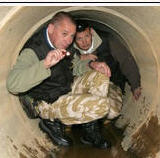Textusa: Blood and the EVRD dog - Part 1
Page 1 of 1 • Share
 Textusa: Blood and the EVRD dog - Part 1
Textusa: Blood and the EVRD dog - Part 1
Wednesday, 29 May 2019
Blood and the EVRD dog - Part 1
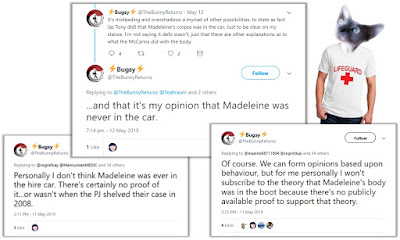
1. Introduction
The Maddie case, in terms of internet, has been rocked by very well-known personalities, Mr Thompson and Sade Anslow, casting doubt over Eddie’s alerts on the Scenic: they only represented alerts to blood.
Later he would say that he wasn’t being adamant, that it could only have been blood not that it was only blood.
However, to say that his opinion was that Maddie’s body was never in the car, sets clearly aside the ‘could’, as it’s his conviction that she was never there:
https://twitter.com/TheBunnyReturnz/status/1127320339539746816
 Bugsy
Bugsy  @TheBunnyReturnz
@TheBunnyReturnz
Replying to @regretkay @MancunianMEDlC and 34 others
Personally I don't think Madeleine was ever in the hire car. There's certainly no proof of it...or wasn't when the PJ shelved their case in 2008.
2:11 PM - 11 May 2019
https://twitter.com/TheBunnyReturnz/status/1127323773118627840
 Bugsy
Bugsy  @TheBunnyReturnz
@TheBunnyReturnz
Replying to @maxine68711804 @regretkay and 34 others
Of course. We can form opinions based upon behaviour, but for me personally I won't subscribe to the theory that Madeleine's body was in the boot because there's no publicly available proof to support that theory.
10:25 pm - 11 May 2019
According to Mr Thompson, there is no ironclad proof that Madeleine’s body was EVER in the Scenic. We call to the attention of the readers that Mr Thompson is a self-proclaimed expert on EVRD dogs, human decomposition and blood. He understands blood, he understands dogs.
In that he accepts to only come second to his don, NotTextusa, the scientist with a degree which we don’t know in what but if we were to guess, we would say it was in drivel and twaddle, the only product he has consistently put out – of very high-quality, it must be recognised – in all the different characters he has been, and they have been so many over the years. Recent events have proved how right we have always been.
And on what does Mr Thompson base his conclusion. From this statement by Martin Grime that is in the PJ Files:
“It is my view that it is possible that the EVRD is alerting to 'cadaver scent' contaminant or human blood scent. No evidential or intelligence reliability can be made from this alert unless it can be confirmed with corroborating evidence.”
“Or human blood scent”, he is very clear, isn’t he? Or maybe he isn’t and that is what we intend to analyse.
This post is the first part of two. In this one we will analyse blood dog and blood in the context that is relevant and that is in the use in tandem of blood and EVRD dogs in sites where a human death is possible, probable or likely to have happened.
We intend to be bold with these 2 posts as at the end of them, show very clearly that Eddie did not alert to blood, decomposed or otherwise and we also intend to show what we believe Mr Grime meant when he said what he said.
As a disclaimer, we unlike some – NotTextusa, Mr Thompson and Sade Anslow, hoping to have respected the gang’s hierarchy – who claim to have unquestioned and above all unquestionable expertise on all of Martin Grime’s areas of expertise , are only providing personal opinions on the subject, based simply on logic and general culture and will evidently be corrected if shown we are wrong by those who sincerely want to help.
One does not have to possess a degree in science or have no more than the basics of physics to know the seriousness of a man standing in front of train to stop it, will end up with the train winning with terrible personal disastrous consequences for the man.
As we believe that Martin Grime is indeed an expert, we have only made an effort to make logical sense of what he said. No twisting, tweaking or adapting.
2. The simpleton school of EVRD dogs and blood
First let’s define who we consider to be a simpleton in the context of this post: that group of people who all have in common an alma mater. They have all graduated from the NotTextusa’s university of drivel.
According to these simpletons, the EVRD dog detects both blood and cadaver scent.
Then, this would be how the dogs work: the EVRD dog walks in, alerts. The alert can be blood or cadaver, at this stage no one knows.
The blood dog is brought in. If the blood dog signals, then it is blood but then one would remain in the situation of not knowing if that blood belonged to a cadaver or if it originated from a simple cut from a domestic accident or a nosebleed. At this stage no one knows whether the EVRD dog alerts are of cadaver or blood as the blood dog does not help in any way clarify that.
The only added value for the blood dog alert to be working in tandem with the EVRD, is that we get to know that there is blood present. That’s it, nothing else.
According to this theory, one still doesn’t get to know if a cadaver was present. And because both dogs alert to blood, what the blood dog alert does in fact is to rule out completely the possibility of us EVER knowing that, as the possibility of being only blood will always be present.
Only if the blood dog doesn’t give any alert, can one be certain that it is cadaver scent but… whose cadaver?
Because science is yet not able to physically retrieve any sample from the cadaver compound residue that the body leaves behind, it can’t extract from it any DNA, then we are left with the uncertainty of who the dead person is.
According to the simpletons, the dogs, alone or together are useless in any scenario.
3. According to simpletons, an always live Maddie
But, will reply the simpleton, that is not so because if BOTH the EVRD and the blood dogs do alert, meaning the possibility of a dead person AND blood present, then it is possible to extract DNA from the blood and determine who the dead person in question is.
No, because where there’s blood, then according to you there’s the strong possibility of it only being blood, as the EVRD dog could be only alerting to that substance. Following their logic, whenever blood is alerted, the possibility of referring to a cadaver must be ruled out, and that’s why Mr Thompson so firmly believes that Maddie’s body was never in the Scenic.
And that’s the reason why the simpletons, undercover pros while waving for all to see and notice the anti colours, want so much for the EVRD to detect both blood and cadaver: it explains the alert in the Scenic and it reduces the dog alerts into saying absolutely nothing about whether Maddie is dead, regardless of whatever DNA results obtained, by Mark Perlin or anyone else for that matter.
This is how relevant this question is. That’s why they cling to Martin Grime’s “or human blood scent” for dear life.
Fortunately for us, these “antis” have over-played their hand and revealed their game.
Let’s imagine that in the Maddie case that Maddie’s DNA was found both in the apartment and in the Scenic. Full, unquestionable 100% matches.
Would that prove, according to the simpleton theory of dogs, that a dead Maddie had been there? Absolutely not.
As said above, according to them, the EVRD “cadaver” alert is to be immediately disregarded as blood was confirmed, so Eddie’s alerts could be just that and there’s no way to eliminate that uncertainty.
And because it can “only” be blood, one has then to take into account the possibility that Maddie struggled when being taken by the abductor and sprayed her blood everywhere in the apartment.
Blood and cadaver alerts in the living-room, fully explained. Let’s continue to accompany the simpleton’s explanation for all.
The scent of cadaver in the bedroom? Well, that could have been from anyone, not necessarily Maddie, as there was no DNA collected there to prove it is her. In fact, if she struggled in the living room, then it would be absurd to think the cadaver scent in the bedroom could be hers. A preposterous thought, even! It has to be from someone else.
Same goes with the flowerbed, cuddle cat and the clothing.
Plus, according to the simpletons, the scent in the flowerbed could have come from a phenomenon similar to someone smoking a cigarette outside as a dead body just happened to pass nearby… Walking Dead not fiction after all?
To those not familiar with Mr Thompson’s cigarette theory, here it is:

“Textusa 27 Jan 2019, 18:38:00
Blood and the EVRD dog - Part 1

1. Introduction
The Maddie case, in terms of internet, has been rocked by very well-known personalities, Mr Thompson and Sade Anslow, casting doubt over Eddie’s alerts on the Scenic: they only represented alerts to blood.
Later he would say that he wasn’t being adamant, that it could only have been blood not that it was only blood.
However, to say that his opinion was that Maddie’s body was never in the car, sets clearly aside the ‘could’, as it’s his conviction that she was never there:
https://twitter.com/TheBunnyReturnz/status/1127320339539746816
Replying to @regretkay @MancunianMEDlC and 34 others
Personally I don't think Madeleine was ever in the hire car. There's certainly no proof of it...or wasn't when the PJ shelved their case in 2008.
2:11 PM - 11 May 2019
https://twitter.com/TheBunnyReturnz/status/1127323773118627840
Replying to @maxine68711804 @regretkay and 34 others
Of course. We can form opinions based upon behaviour, but for me personally I won't subscribe to the theory that Madeleine's body was in the boot because there's no publicly available proof to support that theory.
10:25 pm - 11 May 2019
According to Mr Thompson, there is no ironclad proof that Madeleine’s body was EVER in the Scenic. We call to the attention of the readers that Mr Thompson is a self-proclaimed expert on EVRD dogs, human decomposition and blood. He understands blood, he understands dogs.
In that he accepts to only come second to his don, NotTextusa, the scientist with a degree which we don’t know in what but if we were to guess, we would say it was in drivel and twaddle, the only product he has consistently put out – of very high-quality, it must be recognised – in all the different characters he has been, and they have been so many over the years. Recent events have proved how right we have always been.
And on what does Mr Thompson base his conclusion. From this statement by Martin Grime that is in the PJ Files:
“It is my view that it is possible that the EVRD is alerting to 'cadaver scent' contaminant or human blood scent. No evidential or intelligence reliability can be made from this alert unless it can be confirmed with corroborating evidence.”
“Or human blood scent”, he is very clear, isn’t he? Or maybe he isn’t and that is what we intend to analyse.
This post is the first part of two. In this one we will analyse blood dog and blood in the context that is relevant and that is in the use in tandem of blood and EVRD dogs in sites where a human death is possible, probable or likely to have happened.
We intend to be bold with these 2 posts as at the end of them, show very clearly that Eddie did not alert to blood, decomposed or otherwise and we also intend to show what we believe Mr Grime meant when he said what he said.
As a disclaimer, we unlike some – NotTextusa, Mr Thompson and Sade Anslow, hoping to have respected the gang’s hierarchy – who claim to have unquestioned and above all unquestionable expertise on all of Martin Grime’s areas of expertise , are only providing personal opinions on the subject, based simply on logic and general culture and will evidently be corrected if shown we are wrong by those who sincerely want to help.
One does not have to possess a degree in science or have no more than the basics of physics to know the seriousness of a man standing in front of train to stop it, will end up with the train winning with terrible personal disastrous consequences for the man.
As we believe that Martin Grime is indeed an expert, we have only made an effort to make logical sense of what he said. No twisting, tweaking or adapting.
2. The simpleton school of EVRD dogs and blood
First let’s define who we consider to be a simpleton in the context of this post: that group of people who all have in common an alma mater. They have all graduated from the NotTextusa’s university of drivel.
According to these simpletons, the EVRD dog detects both blood and cadaver scent.
Then, this would be how the dogs work: the EVRD dog walks in, alerts. The alert can be blood or cadaver, at this stage no one knows.
The blood dog is brought in. If the blood dog signals, then it is blood but then one would remain in the situation of not knowing if that blood belonged to a cadaver or if it originated from a simple cut from a domestic accident or a nosebleed. At this stage no one knows whether the EVRD dog alerts are of cadaver or blood as the blood dog does not help in any way clarify that.
The only added value for the blood dog alert to be working in tandem with the EVRD, is that we get to know that there is blood present. That’s it, nothing else.
According to this theory, one still doesn’t get to know if a cadaver was present. And because both dogs alert to blood, what the blood dog alert does in fact is to rule out completely the possibility of us EVER knowing that, as the possibility of being only blood will always be present.
Only if the blood dog doesn’t give any alert, can one be certain that it is cadaver scent but… whose cadaver?
Because science is yet not able to physically retrieve any sample from the cadaver compound residue that the body leaves behind, it can’t extract from it any DNA, then we are left with the uncertainty of who the dead person is.
According to the simpletons, the dogs, alone or together are useless in any scenario.
3. According to simpletons, an always live Maddie
But, will reply the simpleton, that is not so because if BOTH the EVRD and the blood dogs do alert, meaning the possibility of a dead person AND blood present, then it is possible to extract DNA from the blood and determine who the dead person in question is.
No, because where there’s blood, then according to you there’s the strong possibility of it only being blood, as the EVRD dog could be only alerting to that substance. Following their logic, whenever blood is alerted, the possibility of referring to a cadaver must be ruled out, and that’s why Mr Thompson so firmly believes that Maddie’s body was never in the Scenic.
And that’s the reason why the simpletons, undercover pros while waving for all to see and notice the anti colours, want so much for the EVRD to detect both blood and cadaver: it explains the alert in the Scenic and it reduces the dog alerts into saying absolutely nothing about whether Maddie is dead, regardless of whatever DNA results obtained, by Mark Perlin or anyone else for that matter.
This is how relevant this question is. That’s why they cling to Martin Grime’s “or human blood scent” for dear life.
Fortunately for us, these “antis” have over-played their hand and revealed their game.
Let’s imagine that in the Maddie case that Maddie’s DNA was found both in the apartment and in the Scenic. Full, unquestionable 100% matches.
Would that prove, according to the simpleton theory of dogs, that a dead Maddie had been there? Absolutely not.
As said above, according to them, the EVRD “cadaver” alert is to be immediately disregarded as blood was confirmed, so Eddie’s alerts could be just that and there’s no way to eliminate that uncertainty.
And because it can “only” be blood, one has then to take into account the possibility that Maddie struggled when being taken by the abductor and sprayed her blood everywhere in the apartment.
Blood and cadaver alerts in the living-room, fully explained. Let’s continue to accompany the simpleton’s explanation for all.
The scent of cadaver in the bedroom? Well, that could have been from anyone, not necessarily Maddie, as there was no DNA collected there to prove it is her. In fact, if she struggled in the living room, then it would be absurd to think the cadaver scent in the bedroom could be hers. A preposterous thought, even! It has to be from someone else.
Same goes with the flowerbed, cuddle cat and the clothing.
Plus, according to the simpletons, the scent in the flowerbed could have come from a phenomenon similar to someone smoking a cigarette outside as a dead body just happened to pass nearby… Walking Dead not fiction after all?
To those not familiar with Mr Thompson’s cigarette theory, here it is:

“Textusa 27 Jan 2019, 18:38:00
Mr Thompson,
Can you please give a brief explanation as to how the airborne scent remained outside for months to be there and be detected by the dog in the flowerbed.
Pseudo Nym 27 Jan 2019, 18:51:00
Can you explain how your non retrievable residue did?
Scents attach themselves to all manner of things Mr textusa. If I were to sit in a smoky room then go outdoors you would smell it on my clothes right? Martin Grime wasn't certain of this alert anyway. But you should know this. Again, this could be explained by scent pooling, and to understand that, I would urge you to read the book I referred you to above.”
And NotTextusa has presented the possibility for the alert in the flowerbed to have been because of a medieval graveyard.
To those not familiar with NotTextusa’s medieval graveyard theory, here it is:

To this very direct and specific question from us: “If only gas and only airborne contamination why was the scent detected in the backyard? It’s open air, impossible for airborne molecules to remain floating there.”
NotTextusa, the scientist replied in his blog:
“Well, why do you think? Might interest you to know that it’s impossible to field walk in this country without finding small pieces of human bone, due to centuries of ploughing disturbing medieval graves. Consequently, it finds its way into the topsoil very readily. Try thinking outside the box for a change.”
In response to this reply, we said: “All is scientifically explained, so says Insane”, to which NotTextusa, the scientist then said “Which it is [scientifically explained]”.
If the scent of the graveyard or similar to cigarette smoked cadaver scent wafted into the flowerbed then the same scent could have could have just wafted into the bedroom.
The clothes? Kate McCann just happened to have been near so many corpses, wasn’t that so?
In the Scenic, as blood was found, the cadaver possibility ruled out, all will be explained by contamination of blood by Maddie via her clothing or objects she used after having grazed a knee, nosebleed or some other injury no one noticed before she went missing.
Basically, with alerts from both dogs, it could, according to them, mean only be blood, and even if there is a 100% DNA match, it could have come from a live Maddie.
The EVRD alerts only, as they could mean literally anyone who has passed away and not necessarily Maddie, the possibility of her being alive has to be considered.
Maddie is, say the simpletons, alive. At least, they say, it’s a strong possibility and once one accepts the EVRD dog also alerts to blood, nothing in the files contradicts it.
See how important the EVRD dog v blood question is?
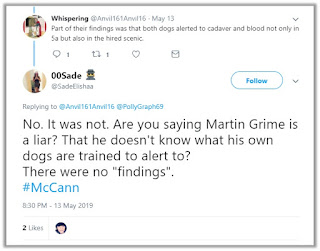

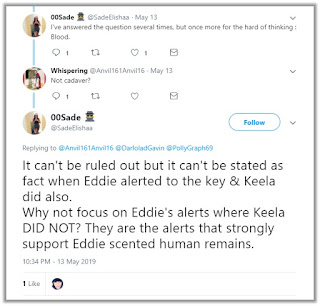
4. Mr Thompson’s farm analogy
So, according to the simpletons, what are the EVRD dogs good for? Absolutely nothing.
We challenge anyone to come up with a scenario within the simpleton theory of dogs, in which the EVRD dog is of any use other than exempting the parents and to cast doubt on the possibility of death ever having happened in the apartment.
We will be waiting for one. A single one.
Mr Thompson on May 15 explains all his reasoning by using the following analogy:
“Understanding how the dogs worked is as simple as adding beans. In fact, to test how easy it was, I tried a little experiment.
My friend's little boy - who is eight, has a little toy farm set. I substituted Eddie and Keela for a horse and a cow.
I then told him the horse was really good at smelling when cake was being baked, and when cookies were being made.
I told him the cow could only smell cookies.
He didn't get it the first time - he was only eight after all, but, after a couple more goes, he understood.
It really is *that* simple. And yet, a small adult who pretends to be of higher intelligence than any other being on the planet, and has had 12 years to get it, STILL can't work out how the dogs work.
Needless to say, myself and my mate's young lad ate the cookies the horse and cow found and I tried not to think about what only I knew the cookie had represented.
Hey, if the loony can have Fred to feature in made up anecdotes, I'm allowed a fucking horse and cow.”
As a snide remark, we would like to inform Mr Thompson that Fred in his story equates to “friend's little boy - who is eight” in his story and not to the horse and cow. Fred is the one who has to listen to me and has not been taught to go and smell cookies. And yes, you are fully allowed to have your “friend's little boy - who is eight” in the story, plus the horse, the cows, the cookies and the oven.
According to Mr Thompson’s analogy, Eddie the horse smells cookies when they are being made and Keela the cow can only smell cookies after they are made.
We are not trying to mock Mr Thompson, in fact we have made an effort to understand what he has said to be able to show how wrong something is so one has to understand with clarity what is being defended and in the analogy, as far as we understood, the horse pretends to be Eddie the EVRD dog and the cow, Keela the blood dog.
And that is as far we could go to understand the analogy.
For example, Mr Thompson thinks he has made the cookies represent blood but he makes a blunder. What his analogy shows is what both the horse and the cow are able to smell is dough, not cookies. The horse (Eddie) alerts to dough in all its different stages in the baking process and the other (Keela) only to when it’s finally cooked, when it’s a cookie.
When the author of an analogy gets the analogy wrong, then it’s very hard to make heads or tails of it, no matter how hard one tries. And we tried, we really did.
We understood that Mr Thompson brought in decomposition as the baking process, which we agree he should but as shown above we don’t think he knew what he meant.
One thing that Mr Thompson does not make clear in his analogy is whether the horse also signals the fully cooked cookie, because if he does, Mr Thompson is saying that both dogs are dough dogs. The difference is that one can smell the dough during the entire baking process and the other only at the end. But, bottom line, both horse and cow could both only be alerting to a fully baked cookie.
We think that’s what he means because if the horse (Eddie) could only smell dough before being fully baked and the cow (Keela) only the baked cookie, then their alerts could not be confused and we think he’s trying to give an example how one alert, the one of the baking process, could be confused with just being an alert to a fully baked cookie.
For starters, Mr Thompson gets his animals wrong in the analogy. Decomposition, in regards with what is relevant for the analysis is an evolving process not an end-state, it’s not a baked cookie. His analogy to be correct, he should have said that one animal, Keela the cow was only able to smell unbaked dough, while Eddie the horse could smell dough from unbaked to fully baked.
Then the analogy would make sense because then we could all understand what he was trying to illustrate and that would be how one dog alerted only to fresh blood (unbaked dough) and the other alerted to both fresh (unbaked) and decomposed blood (baked dough).
Even when being criticised by someone who is not nice to us like Mr Thompson, we have to help him out. If that doesn’t show that we are capable to set aside personal differences in the quest for the truth, nothing else will.
So, pushing to the best of our ability to turn Mr Thompson’s analogy against us,, this is what we think he’s trying to say: Keela alerts to fresh blood (supposedly blood from a living human being) and Eddie to blood both decomposed (supposedly blood from a dead human being) and fresh blood (supposedly from a living human being), meaning Eddie’s alerts could be blood from a living human being, so the body may not have been present in the Scenic, in fact it is Mr Thompson’s firm opinion that it was not.
Honestly, we cannot turn his analogy more against us. If that is possible, our apologies but we will proceed assuming that we have nailed it.
5. The topic of decomposition of blood
Mr Thompson brings up a very interesting point that we have never seen debated: the decomposition of blood.
The decomposition of the entire human being has been discussed but that of blood spilled out of the body, it is something no one speaks of.
People just say, blood from a living person or blood from a dead person, meaning one is “fresh” and the other “decomposed” forgetting that fresh blood, as any biological product undergoes a decomposition process.
Saying decomposed blood is meaningless when it comes to determining whether it came from a living human being (or from a recently diseased one) or from a dead one.
In fact, the blood in a crime scene is more likely to be all fresh blood because usually the victim was alive or in the process of losing their life when the bleeding occurred. Also, the blood could have oozed out very shortly after death, when decomposition hadn’t started or if it had, was not yet noticeable.
There is only one scenario where there no fresh blood and only blood from a dead person and that would be the one where the body is moved after decomposition is noticeable. That’s easy to understand, it’s when a body first enters the premises long after death, the blood it may come out of it cannot be considered fresh. The scenario of the body in the Scenic would fit into that scenario, for example.
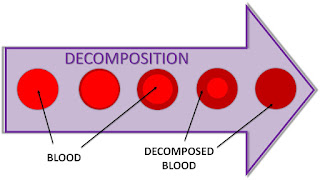
This to say a blood dog does not alert to fresh blood but to blood that even though it left the body fresh is within its own blood decomposing process in a status depending on the time lapsed after it left the body.
To be easier to understand, if one was to use a colour palette to illustrate the scents a blood dog alerts to, it would look like this:

Very simple. On the left the scent of fresh blood and on the right, decomposed. The dog would alert to both and all in-between.
Please note that when a blood dog alerts to blood, as time has passed after the bleeding, the scent would be one between somewhere in the middle to the far right of the palette, meaning blood noticeably decomposed, regardless of whether it had been fresh when it contaminated the crime scene.
To understand, if the blood alerted to belongs to Maddie, as we believe it does, it would have left her body during or shortly after her death and would have the exact same characteristics if she had bled it a few hours before when she was alive. In both instances, it would have been fresh blood when spilled but with the decomposition of 3 months when alerted to by Keela.
In practical terms, in apartment 5A Keela would have alerted to Maddie’s blood (a recently dead person) as she would have to the blood from the alleged shaving accident (live person), without establishing any difference about its origins in terms of being a dead or live person.
And this reasoning also applies to the blood alerted to in the Scenic. For Keela, the blood found there is just human blood. This detail may seem unimportant now but is very, very important as the reader will see when we analyse the EVRD dog in the next post.
6. Blood decomposition v Human decomposition
As said above, blood decomposition is a topic that we have never seen debated. And it turns out it is something that should have been, because it is very relevant to the case.
The reader may ask, but isn’t blood decomposition the same as human decomposition?
No, it isn’t. Stand-alone blood, found frequently in crime scenes and in every common household has its own decomposition process, which is way simpler than that of the entire human body.
And it’s quite easy to understand why. Will just bring over what Wikipedia says about blood:
https://en.wikipedia.org/wiki/Blood
“Blood is a body fluid in humans and other animals that delivers necessary substances such as nutrients and oxygen to the cells and transports metabolic waste products away from those same cells.
In vertebrates, it is composed of blood cells suspended in blood plasma. Plasma, which constitutes 55% of blood fluid, is mostly water (92% by volume), and contains proteins, glucose, mineral ions, hormones, carbon dioxide (plasma being the main medium for excretory product transportation), and blood cells themselves. Albumin is the main protein in plasma, and it functions to regulate the colloidal osmotic pressure of blood. The blood cells are mainly red blood cells (also called RBCs or erythrocytes), white blood cells (also called WBCs or leukocytes) and platelets (also called thrombocytes). The most abundant cells in vertebrate blood are red blood cells. These contain hemoglobin, an iron-containing protein, which facilitates oxygen transport by reversibly binding to this respiratory gas and greatly increasing its solubility in blood. In contrast, carbon dioxide is mostly transported extracellularly as bicarbonate ion transported in plasma.”
It contains quite a lot of scientific language but could the above even begin to describe the complexity of the human body? Of course not.
One does not need to have the eye of an eagle to tell apart a tree from a rabbit. They are physically different. One does not need to go read in a science book what makes a tree and rabbit different, one just has to trust one’s eyes. One may have to go and research to tell the differences between a rabbit and a hare apart but not about what distinguishes a tree from a rabbit.
One does not have to do any research to understand that if decomposition is, to sum it up, the process of breakdown of the various “components” of an organism, then general culture is sufficient to understand the difference between the low number of “components” that make up blood with the absurd number of those that make up the entire human body, to see that no comparison between them is possible.
In terms of complexity would be to compare primary school arithmetic with an Abel Prize winning mathematic thesis.
And most of us have had, directly or indirectly, the experience to know the difference and we’re speaking about those who have had the experience of letting meat rot or know of a friend to whom that happened.
That stench which lingers interminably in permeable surfaces, such as occurs when meat is left to defrost and rot in a freezer which has switched off without our noticing; in spite of determined efforts to clean and refresh. A stench so aggressive so distinctive that one can even still smell faint odours from it occasionally long after it was cleaned.
Rotting meat produces a stink, a vile stench that is pungent, very strong and sickening and that is a smell that dried blood doesn’t produce. And how does everyone know that, even those who have been lucky to never have been near rotting meat?
Because decomposed blood does not produce stench and we all have, literally in every household and because of nosebleeds, shaving cuts and kitchen mishaps, decomposed human blood in our houses. If blood produced such a stench, we all would notice and our houses would become unbearable to live in.
The argument may be that the size between a piece of rotting meat and household blood stains differ, only those who have not gone through such an unpleasant experience could ever say such nonsense.
The stench of rotting meat remains after one has washed it away many times, using all chemicals invented and those yet to invent, is so aggressive to the nose. One literally reduces it to quantities invisible to the naked eye and the stench persists. If the decomposition of blood was as anywhere similar in terms of smell to the decomposition of rotting meat, then blood would produce the same stench and it doesn’t.
No one has ever complained about the stench of blood in their homes. In fact, the end result of the decomposition of blood is not an unpleasant smell at all:
https://www.quora.com/What-does-decomposing-blood-look-like-outside-of-the-body
“What does decomposing blood look like outside of the body?
The plasma, or the liquid portion, unless in a vial with some type of anticoagulant, will evaporate leaving a film of proteins, which will degrade out of the body. The blood cells will die rather rapidly outside the body as well. So essentially, decomposing blood will smell kind of metallic due to its trace minerals such as iron and copper. It will then appear as a dark reddish stain that has dried up.
Janet Caruana, former Laboratory Technologist at Winthrop University Hospital (1999-2009)
Answered Dec 30 2017 · Author has 2.2k answers and 2.1m answer views”
Kind of metallic. Is that the stench one gets from rotting meat? No, it is not.
It’s very clear that the scent of decomposing blood cannot be confused with the one from human decomposition.
Saying that the EVRD dog also alerts to blood is as ridiculous as saying that Mr Thompson’s horse or cow trained to alert to fully baked cookies would also alert to grilled sardines.
7. Blood decomposition
We are certain the subject has been studied but we could not find any specifics on blood decomposition per se.
Even the Wikipedia page for blood does not mention it at all.
But Janet Caruana is clear that the plasma leaves “a film of proteins, which will degrade out of the body”. Decomposition or degradation is transformation. She also says “that blood cells will die rather rapidly” and we imagine that the same will happen to the white ones.
Meaning that there is some sort of decomposition process that is peculiar to blood. That means that blood straight out of the body, or fresh, will have a different scent than one that is fully decomposed. Blood dogs are trained to react to a scent within this range.
Above would then be the range of scents that Keela, or any blood dog alerts to. She alerts to blood in all its decomposing states.
As a side-note, the above debunks NotTextusa´s gaseous theory of human decomposition. If plasma (which is a significant part of the human body) decomposition leaves “a film of protein” and this is just one of the many, many decomposition processes involved (and this one in particular involves evaporation to boot!) that added up make-up the human decomposition process which produces whatever it does, which we have called cadaver compound, which releases the scent the EVRD dogs are trained to react to.
8. Complexities
The decomposition of a human being is so complex that science has been unable to determine what exactly is happening. One reason for this, is that there are too many variables to quantify. For example, we have spoken of stand-alone blood and that only involves the decomposition of plasma, red and white cells.
The three processes we have just listed are within one that encompasses them which is blood decomposition. Blood decomposition, is but one of many, many decomposition systems within an extremely complex process that is human decomposition.
To compare the description of the decomposition of human blood against the decomposition that happens with the entire human being, would be like describing what the fuel a car uses is made up of compared to describing to all the finest detail of the most technologically advanced spaceship, including the fuel it uses.

That’s why it’s easy to understand the complexity of the scent that the blood alerts to has absolutely no comparison, by default, with the complexity of the scent the EVRD alerts to.
To even attempt to say that because the scent the blood dog alerts to is “within” the scent the one the EVRD alerts to is like the pros attempting to say that Eddie alerts to urine because it contains cadaverine.
The scent the EVRD alerts is one unique scent, not different scents that the dog checks on some sort of check-list that when he has checked reaches a certain number, he puts down the list and alerts.
The fact that a scent has a range does not make it a multitude of scents, like we showed for the blood dog. The scent has a commonality in all its range and that is what makes it unique because it is unique.
9. Dogs in tandem
Are we diminishing Keela’s importance in the detection of blood by saying she just detects blood but being unable to determine if it came from a live or dead person?
We are not, in any way.
This is how we say the dogs work in tandem. Eddie walks in and alerts to an area. That alert limits an area where a cadaver has been. This is unquestionable evidence, not up for debate.
Keela then comes in and helps in the collection of further evidence on site by alerting, if that is the case, to blood and pointing the locations with greater precision than Eddie.
Eddie alerts and Keela doesn’t, it determines forensically the presence of a body within the area/location/object determined by the dog’s trainer.
Eddie alerts and Keela alerts, means that within the area Eddie proved a human dead body had been, there is blood. Again, no need for further forensics.
The pinpointing with precision of exact location where the blood is, to whom the blood belongs to is up to human forensics.
What conclusions can be made after knowing the locations of the blood and to whom the blood belongs to, is up to police intelligence.
The job of the dogs is to say, here was a cadaver and where the cadaver was there is blood. That’s it. And that’s really a lot.
10. Conclusion
The EVRD dog does not alert to blood. That is what the blood dog is for.
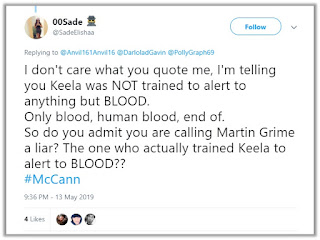
The EVRD dog was NOT trained to alert to anything but CADAVER SCENT. Only cadaver scent, human cadaver scent. end of.
To say that the EVRD dog alerts to blood because it’s decomposed blood, is absurd as blood cannot be compared to a human body in terms of complexity. It’s just exploiting how the word “decomposed” sounds in our minds. To say the EVRD dogs alert to decomposed blood has the exactly the same logic as saying that they alert to a decomposed cabbage.
To say that the EVRD dog alerts to blood is to mislead on purpose. To discredit on purpose the EVRD dog but, and that is the real objective, to reduce the importance of the alerts from BOTH dogs to nothing.
Martin Grime does say “It is my view that it is possible that the EVRD is alerting to 'cadaver scent' contaminant or human blood scent. No evidential or intelligence reliability can be made from this alert unless it can be confirmed with corroborating evidence.”
Martin Grime is pretty adamant and we certainly do not think Martin Grime to be stupid.
But if the simpletons were right about the EVRD dog also alerting to blood, then the supporters of the hoax, in which the McCanns are included, wouldn’t have absolutely anything to worry about whatever results Mark Perlin may produce if his offer is accepted.
As according to them the EVRD alerts in the Scenic could only be blood, a 100% match with Madeleine’s DNA could be explained with blood spilled by her before she disappeared.
But they are worried about the results Mark Perlin may produce, aren’t they? Really worried. Very worried.

Maybe the simpletons should take to their own advice and read, because reading means being able to read beyond a single sentence. Maybe that will stop them having the arrogance of thinking they know more than the Portuguese justice system.

To be continued.
Can you please give a brief explanation as to how the airborne scent remained outside for months to be there and be detected by the dog in the flowerbed.
Pseudo Nym 27 Jan 2019, 18:51:00
Can you explain how your non retrievable residue did?
Scents attach themselves to all manner of things Mr textusa. If I were to sit in a smoky room then go outdoors you would smell it on my clothes right? Martin Grime wasn't certain of this alert anyway. But you should know this. Again, this could be explained by scent pooling, and to understand that, I would urge you to read the book I referred you to above.”
And NotTextusa has presented the possibility for the alert in the flowerbed to have been because of a medieval graveyard.
To those not familiar with NotTextusa’s medieval graveyard theory, here it is:

To this very direct and specific question from us: “If only gas and only airborne contamination why was the scent detected in the backyard? It’s open air, impossible for airborne molecules to remain floating there.”
NotTextusa, the scientist replied in his blog:
“Well, why do you think? Might interest you to know that it’s impossible to field walk in this country without finding small pieces of human bone, due to centuries of ploughing disturbing medieval graves. Consequently, it finds its way into the topsoil very readily. Try thinking outside the box for a change.”
In response to this reply, we said: “All is scientifically explained, so says Insane”, to which NotTextusa, the scientist then said “Which it is [scientifically explained]”.
If the scent of the graveyard or similar to cigarette smoked cadaver scent wafted into the flowerbed then the same scent could have could have just wafted into the bedroom.
The clothes? Kate McCann just happened to have been near so many corpses, wasn’t that so?
In the Scenic, as blood was found, the cadaver possibility ruled out, all will be explained by contamination of blood by Maddie via her clothing or objects she used after having grazed a knee, nosebleed or some other injury no one noticed before she went missing.
Basically, with alerts from both dogs, it could, according to them, mean only be blood, and even if there is a 100% DNA match, it could have come from a live Maddie.
The EVRD alerts only, as they could mean literally anyone who has passed away and not necessarily Maddie, the possibility of her being alive has to be considered.
Maddie is, say the simpletons, alive. At least, they say, it’s a strong possibility and once one accepts the EVRD dog also alerts to blood, nothing in the files contradicts it.
See how important the EVRD dog v blood question is?



4. Mr Thompson’s farm analogy
So, according to the simpletons, what are the EVRD dogs good for? Absolutely nothing.
We challenge anyone to come up with a scenario within the simpleton theory of dogs, in which the EVRD dog is of any use other than exempting the parents and to cast doubt on the possibility of death ever having happened in the apartment.
We will be waiting for one. A single one.
Mr Thompson on May 15 explains all his reasoning by using the following analogy:
“Understanding how the dogs worked is as simple as adding beans. In fact, to test how easy it was, I tried a little experiment.
My friend's little boy - who is eight, has a little toy farm set. I substituted Eddie and Keela for a horse and a cow.
I then told him the horse was really good at smelling when cake was being baked, and when cookies were being made.
I told him the cow could only smell cookies.
He didn't get it the first time - he was only eight after all, but, after a couple more goes, he understood.
It really is *that* simple. And yet, a small adult who pretends to be of higher intelligence than any other being on the planet, and has had 12 years to get it, STILL can't work out how the dogs work.
Needless to say, myself and my mate's young lad ate the cookies the horse and cow found and I tried not to think about what only I knew the cookie had represented.
Hey, if the loony can have Fred to feature in made up anecdotes, I'm allowed a fucking horse and cow.”
As a snide remark, we would like to inform Mr Thompson that Fred in his story equates to “friend's little boy - who is eight” in his story and not to the horse and cow. Fred is the one who has to listen to me and has not been taught to go and smell cookies. And yes, you are fully allowed to have your “friend's little boy - who is eight” in the story, plus the horse, the cows, the cookies and the oven.
According to Mr Thompson’s analogy, Eddie the horse smells cookies when they are being made and Keela the cow can only smell cookies after they are made.
We are not trying to mock Mr Thompson, in fact we have made an effort to understand what he has said to be able to show how wrong something is so one has to understand with clarity what is being defended and in the analogy, as far as we understood, the horse pretends to be Eddie the EVRD dog and the cow, Keela the blood dog.
And that is as far we could go to understand the analogy.
For example, Mr Thompson thinks he has made the cookies represent blood but he makes a blunder. What his analogy shows is what both the horse and the cow are able to smell is dough, not cookies. The horse (Eddie) alerts to dough in all its different stages in the baking process and the other (Keela) only to when it’s finally cooked, when it’s a cookie.
When the author of an analogy gets the analogy wrong, then it’s very hard to make heads or tails of it, no matter how hard one tries. And we tried, we really did.
We understood that Mr Thompson brought in decomposition as the baking process, which we agree he should but as shown above we don’t think he knew what he meant.
One thing that Mr Thompson does not make clear in his analogy is whether the horse also signals the fully cooked cookie, because if he does, Mr Thompson is saying that both dogs are dough dogs. The difference is that one can smell the dough during the entire baking process and the other only at the end. But, bottom line, both horse and cow could both only be alerting to a fully baked cookie.
We think that’s what he means because if the horse (Eddie) could only smell dough before being fully baked and the cow (Keela) only the baked cookie, then their alerts could not be confused and we think he’s trying to give an example how one alert, the one of the baking process, could be confused with just being an alert to a fully baked cookie.
For starters, Mr Thompson gets his animals wrong in the analogy. Decomposition, in regards with what is relevant for the analysis is an evolving process not an end-state, it’s not a baked cookie. His analogy to be correct, he should have said that one animal, Keela the cow was only able to smell unbaked dough, while Eddie the horse could smell dough from unbaked to fully baked.
Then the analogy would make sense because then we could all understand what he was trying to illustrate and that would be how one dog alerted only to fresh blood (unbaked dough) and the other alerted to both fresh (unbaked) and decomposed blood (baked dough).
Even when being criticised by someone who is not nice to us like Mr Thompson, we have to help him out. If that doesn’t show that we are capable to set aside personal differences in the quest for the truth, nothing else will.
So, pushing to the best of our ability to turn Mr Thompson’s analogy against us,, this is what we think he’s trying to say: Keela alerts to fresh blood (supposedly blood from a living human being) and Eddie to blood both decomposed (supposedly blood from a dead human being) and fresh blood (supposedly from a living human being), meaning Eddie’s alerts could be blood from a living human being, so the body may not have been present in the Scenic, in fact it is Mr Thompson’s firm opinion that it was not.
Honestly, we cannot turn his analogy more against us. If that is possible, our apologies but we will proceed assuming that we have nailed it.
5. The topic of decomposition of blood
Mr Thompson brings up a very interesting point that we have never seen debated: the decomposition of blood.
The decomposition of the entire human being has been discussed but that of blood spilled out of the body, it is something no one speaks of.
People just say, blood from a living person or blood from a dead person, meaning one is “fresh” and the other “decomposed” forgetting that fresh blood, as any biological product undergoes a decomposition process.
Saying decomposed blood is meaningless when it comes to determining whether it came from a living human being (or from a recently diseased one) or from a dead one.
In fact, the blood in a crime scene is more likely to be all fresh blood because usually the victim was alive or in the process of losing their life when the bleeding occurred. Also, the blood could have oozed out very shortly after death, when decomposition hadn’t started or if it had, was not yet noticeable.
There is only one scenario where there no fresh blood and only blood from a dead person and that would be the one where the body is moved after decomposition is noticeable. That’s easy to understand, it’s when a body first enters the premises long after death, the blood it may come out of it cannot be considered fresh. The scenario of the body in the Scenic would fit into that scenario, for example.

This to say a blood dog does not alert to fresh blood but to blood that even though it left the body fresh is within its own blood decomposing process in a status depending on the time lapsed after it left the body.
To be easier to understand, if one was to use a colour palette to illustrate the scents a blood dog alerts to, it would look like this:

Very simple. On the left the scent of fresh blood and on the right, decomposed. The dog would alert to both and all in-between.
Please note that when a blood dog alerts to blood, as time has passed after the bleeding, the scent would be one between somewhere in the middle to the far right of the palette, meaning blood noticeably decomposed, regardless of whether it had been fresh when it contaminated the crime scene.
To understand, if the blood alerted to belongs to Maddie, as we believe it does, it would have left her body during or shortly after her death and would have the exact same characteristics if she had bled it a few hours before when she was alive. In both instances, it would have been fresh blood when spilled but with the decomposition of 3 months when alerted to by Keela.
In practical terms, in apartment 5A Keela would have alerted to Maddie’s blood (a recently dead person) as she would have to the blood from the alleged shaving accident (live person), without establishing any difference about its origins in terms of being a dead or live person.
And this reasoning also applies to the blood alerted to in the Scenic. For Keela, the blood found there is just human blood. This detail may seem unimportant now but is very, very important as the reader will see when we analyse the EVRD dog in the next post.
6. Blood decomposition v Human decomposition
As said above, blood decomposition is a topic that we have never seen debated. And it turns out it is something that should have been, because it is very relevant to the case.
The reader may ask, but isn’t blood decomposition the same as human decomposition?
No, it isn’t. Stand-alone blood, found frequently in crime scenes and in every common household has its own decomposition process, which is way simpler than that of the entire human body.
And it’s quite easy to understand why. Will just bring over what Wikipedia says about blood:
https://en.wikipedia.org/wiki/Blood
“Blood is a body fluid in humans and other animals that delivers necessary substances such as nutrients and oxygen to the cells and transports metabolic waste products away from those same cells.
In vertebrates, it is composed of blood cells suspended in blood plasma. Plasma, which constitutes 55% of blood fluid, is mostly water (92% by volume), and contains proteins, glucose, mineral ions, hormones, carbon dioxide (plasma being the main medium for excretory product transportation), and blood cells themselves. Albumin is the main protein in plasma, and it functions to regulate the colloidal osmotic pressure of blood. The blood cells are mainly red blood cells (also called RBCs or erythrocytes), white blood cells (also called WBCs or leukocytes) and platelets (also called thrombocytes). The most abundant cells in vertebrate blood are red blood cells. These contain hemoglobin, an iron-containing protein, which facilitates oxygen transport by reversibly binding to this respiratory gas and greatly increasing its solubility in blood. In contrast, carbon dioxide is mostly transported extracellularly as bicarbonate ion transported in plasma.”
It contains quite a lot of scientific language but could the above even begin to describe the complexity of the human body? Of course not.
One does not need to have the eye of an eagle to tell apart a tree from a rabbit. They are physically different. One does not need to go read in a science book what makes a tree and rabbit different, one just has to trust one’s eyes. One may have to go and research to tell the differences between a rabbit and a hare apart but not about what distinguishes a tree from a rabbit.
One does not have to do any research to understand that if decomposition is, to sum it up, the process of breakdown of the various “components” of an organism, then general culture is sufficient to understand the difference between the low number of “components” that make up blood with the absurd number of those that make up the entire human body, to see that no comparison between them is possible.
In terms of complexity would be to compare primary school arithmetic with an Abel Prize winning mathematic thesis.
And most of us have had, directly or indirectly, the experience to know the difference and we’re speaking about those who have had the experience of letting meat rot or know of a friend to whom that happened.
That stench which lingers interminably in permeable surfaces, such as occurs when meat is left to defrost and rot in a freezer which has switched off without our noticing; in spite of determined efforts to clean and refresh. A stench so aggressive so distinctive that one can even still smell faint odours from it occasionally long after it was cleaned.
Rotting meat produces a stink, a vile stench that is pungent, very strong and sickening and that is a smell that dried blood doesn’t produce. And how does everyone know that, even those who have been lucky to never have been near rotting meat?
Because decomposed blood does not produce stench and we all have, literally in every household and because of nosebleeds, shaving cuts and kitchen mishaps, decomposed human blood in our houses. If blood produced such a stench, we all would notice and our houses would become unbearable to live in.
The argument may be that the size between a piece of rotting meat and household blood stains differ, only those who have not gone through such an unpleasant experience could ever say such nonsense.
The stench of rotting meat remains after one has washed it away many times, using all chemicals invented and those yet to invent, is so aggressive to the nose. One literally reduces it to quantities invisible to the naked eye and the stench persists. If the decomposition of blood was as anywhere similar in terms of smell to the decomposition of rotting meat, then blood would produce the same stench and it doesn’t.
No one has ever complained about the stench of blood in their homes. In fact, the end result of the decomposition of blood is not an unpleasant smell at all:
https://www.quora.com/What-does-decomposing-blood-look-like-outside-of-the-body
“What does decomposing blood look like outside of the body?
The plasma, or the liquid portion, unless in a vial with some type of anticoagulant, will evaporate leaving a film of proteins, which will degrade out of the body. The blood cells will die rather rapidly outside the body as well. So essentially, decomposing blood will smell kind of metallic due to its trace minerals such as iron and copper. It will then appear as a dark reddish stain that has dried up.
Janet Caruana, former Laboratory Technologist at Winthrop University Hospital (1999-2009)
Answered Dec 30 2017 · Author has 2.2k answers and 2.1m answer views”
Kind of metallic. Is that the stench one gets from rotting meat? No, it is not.
It’s very clear that the scent of decomposing blood cannot be confused with the one from human decomposition.
Saying that the EVRD dog also alerts to blood is as ridiculous as saying that Mr Thompson’s horse or cow trained to alert to fully baked cookies would also alert to grilled sardines.
7. Blood decomposition
We are certain the subject has been studied but we could not find any specifics on blood decomposition per se.
Even the Wikipedia page for blood does not mention it at all.
But Janet Caruana is clear that the plasma leaves “a film of proteins, which will degrade out of the body”. Decomposition or degradation is transformation. She also says “that blood cells will die rather rapidly” and we imagine that the same will happen to the white ones.
Meaning that there is some sort of decomposition process that is peculiar to blood. That means that blood straight out of the body, or fresh, will have a different scent than one that is fully decomposed. Blood dogs are trained to react to a scent within this range.
Above would then be the range of scents that Keela, or any blood dog alerts to. She alerts to blood in all its decomposing states.
As a side-note, the above debunks NotTextusa´s gaseous theory of human decomposition. If plasma (which is a significant part of the human body) decomposition leaves “a film of protein” and this is just one of the many, many decomposition processes involved (and this one in particular involves evaporation to boot!) that added up make-up the human decomposition process which produces whatever it does, which we have called cadaver compound, which releases the scent the EVRD dogs are trained to react to.
8. Complexities
The decomposition of a human being is so complex that science has been unable to determine what exactly is happening. One reason for this, is that there are too many variables to quantify. For example, we have spoken of stand-alone blood and that only involves the decomposition of plasma, red and white cells.
The three processes we have just listed are within one that encompasses them which is blood decomposition. Blood decomposition, is but one of many, many decomposition systems within an extremely complex process that is human decomposition.
To compare the description of the decomposition of human blood against the decomposition that happens with the entire human being, would be like describing what the fuel a car uses is made up of compared to describing to all the finest detail of the most technologically advanced spaceship, including the fuel it uses.

That’s why it’s easy to understand the complexity of the scent that the blood alerts to has absolutely no comparison, by default, with the complexity of the scent the EVRD alerts to.
To even attempt to say that because the scent the blood dog alerts to is “within” the scent the one the EVRD alerts to is like the pros attempting to say that Eddie alerts to urine because it contains cadaverine.
The scent the EVRD alerts is one unique scent, not different scents that the dog checks on some sort of check-list that when he has checked reaches a certain number, he puts down the list and alerts.
The fact that a scent has a range does not make it a multitude of scents, like we showed for the blood dog. The scent has a commonality in all its range and that is what makes it unique because it is unique.
9. Dogs in tandem
Are we diminishing Keela’s importance in the detection of blood by saying she just detects blood but being unable to determine if it came from a live or dead person?
We are not, in any way.
This is how we say the dogs work in tandem. Eddie walks in and alerts to an area. That alert limits an area where a cadaver has been. This is unquestionable evidence, not up for debate.
Keela then comes in and helps in the collection of further evidence on site by alerting, if that is the case, to blood and pointing the locations with greater precision than Eddie.
Eddie alerts and Keela doesn’t, it determines forensically the presence of a body within the area/location/object determined by the dog’s trainer.
Eddie alerts and Keela alerts, means that within the area Eddie proved a human dead body had been, there is blood. Again, no need for further forensics.
The pinpointing with precision of exact location where the blood is, to whom the blood belongs to is up to human forensics.
What conclusions can be made after knowing the locations of the blood and to whom the blood belongs to, is up to police intelligence.
The job of the dogs is to say, here was a cadaver and where the cadaver was there is blood. That’s it. And that’s really a lot.
10. Conclusion
The EVRD dog does not alert to blood. That is what the blood dog is for.

The EVRD dog was NOT trained to alert to anything but CADAVER SCENT. Only cadaver scent, human cadaver scent. end of.
To say that the EVRD dog alerts to blood because it’s decomposed blood, is absurd as blood cannot be compared to a human body in terms of complexity. It’s just exploiting how the word “decomposed” sounds in our minds. To say the EVRD dogs alert to decomposed blood has the exactly the same logic as saying that they alert to a decomposed cabbage.
To say that the EVRD dog alerts to blood is to mislead on purpose. To discredit on purpose the EVRD dog but, and that is the real objective, to reduce the importance of the alerts from BOTH dogs to nothing.
Martin Grime does say “It is my view that it is possible that the EVRD is alerting to 'cadaver scent' contaminant or human blood scent. No evidential or intelligence reliability can be made from this alert unless it can be confirmed with corroborating evidence.”
Martin Grime is pretty adamant and we certainly do not think Martin Grime to be stupid.
But if the simpletons were right about the EVRD dog also alerting to blood, then the supporters of the hoax, in which the McCanns are included, wouldn’t have absolutely anything to worry about whatever results Mark Perlin may produce if his offer is accepted.
As according to them the EVRD alerts in the Scenic could only be blood, a 100% match with Madeleine’s DNA could be explained with blood spilled by her before she disappeared.
But they are worried about the results Mark Perlin may produce, aren’t they? Really worried. Very worried.

Maybe the simpletons should take to their own advice and read, because reading means being able to read beyond a single sentence. Maybe that will stop them having the arrogance of thinking they know more than the Portuguese justice system.

To be continued.
http://textusa.blogspot.com/2019/05/blood-and-evrd-dog-part-1.html#more
____________________
PeterMac's FREE e-book
Gonçalo Amaral: The truth of the lie
CMOMM & MMRG Blog

Jill Havern- Forum Owner & Chief Faffer

- Posts : 28672
Activity : 41394
Likes received : 7710
Join date : 2009-11-25
Location : Parallel universe
 Similar topics
Similar topics» EVRD and CSI Dogs
» EVRD and CSI Dogs
» EVRD and CSI Dogs
» THE 17-PAGE LIST OF OF POLICE OFFICERS, PUBLIC OFFICIALS, AUTHORS, WEBSITES, BLOGGERS ETC given to the High Court by Tony Bennett in the contempt of court case of McCanns v Bennett
» Appearances can be deceptive, Part One /UPDATED with Part Two
» EVRD and CSI Dogs
» EVRD and CSI Dogs
» THE 17-PAGE LIST OF OF POLICE OFFICERS, PUBLIC OFFICIALS, AUTHORS, WEBSITES, BLOGGERS ETC given to the High Court by Tony Bennett in the contempt of court case of McCanns v Bennett
» Appearances can be deceptive, Part One /UPDATED with Part Two
Page 1 of 1
Permissions in this forum:
You cannot reply to topics in this forum


















